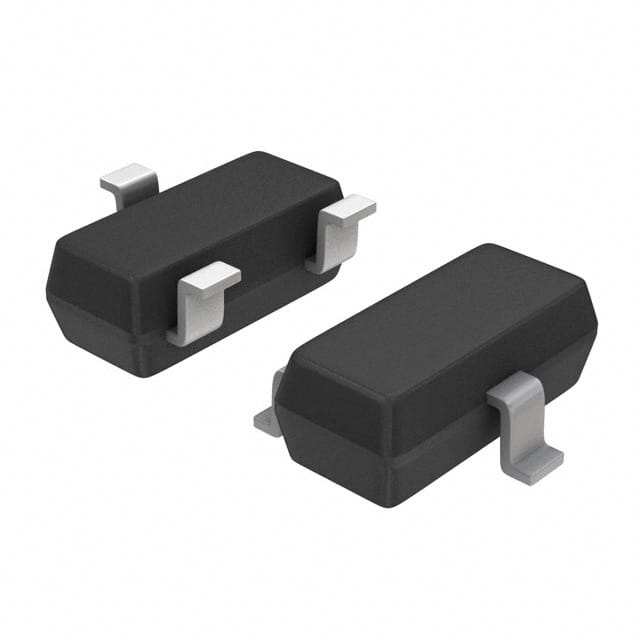MMBZ5238BLT1
Introduction
The MMBZ5238BLT1 is a zener diode that belongs to the category of semiconductor devices. It is commonly used for voltage regulation and protection in electronic circuits. This entry provides an overview of the MMBZ5238BLT1, including its basic information, specifications, pin configuration, functional features, advantages and disadvantages, working principles, application field plans, and alternative models.
Basic Information Overview
- Category: Semiconductor device (Zener diode)
- Use: Voltage regulation and protection in electronic circuits
- Characteristics: Provides a stable reference voltage, low leakage current, and high reliability
- Package: SOT-23
- Essence: Zener diode with a nominal voltage of 6.2V
- Packaging/Quantity: Available in tape and reel packaging with varying quantities
Specifications
- Nominal Voltage: 6.2V
- Power Dissipation: 350mW
- Operating Temperature Range: -65°C to +150°C
- Zener Impedance: 40Ω
- Maximum Reverse Leakage Current: 100nA
Detailed Pin Configuration
The MMBZ5238BLT1 zener diode has three pins: Anode, Cathode, and No Connection (NC). - Anode (A): Connects to the positive terminal of the circuit - Cathode (K): Connects to the negative terminal of the circuit - No Connection (NC): Not internally connected
Functional Features
- Provides a stable voltage reference
- Protects sensitive components from voltage spikes
- Low reverse leakage current
- Small form factor for space-constrained applications
Advantages and Disadvantages
Advantages
- Stable voltage regulation
- High reliability
- Low reverse leakage current
- Small package size
Disadvantages
- Limited power dissipation capability
- Sensitivity to temperature variations
Working Principles
The MMBZ5238BLT1 operates based on the principle of the Zener effect, where it maintains a constant voltage drop across its terminals when it is reverse-biased. This allows it to regulate the voltage in a circuit and protect other components from overvoltage conditions.
Detailed Application Field Plans
The MMBZ5238BLT1 is widely used in various electronic circuits, including: - Voltage regulators - Overvoltage protection circuits - Signal conditioning circuits - Power management systems
Detailed and Complete Alternative Models
Some alternative models to the MMBZ5238BLT1 include: - MMBZ5237BLT1 (6.0V nominal voltage) - MMBZ5239BLT1 (6.4V nominal voltage) - BZX84C6V2LT1 (6.2V nominal voltage)
In conclusion, the MMBZ5238BLT1 zener diode is a crucial component in electronic circuits, providing stable voltage regulation and protection. Its compact size and reliable performance make it suitable for a wide range of applications.
(Word count: 411)
Lista 10 Vanliga frågor och svar relaterade till tillämpningen av MMBZ5238BLT1 i tekniska lösningar
What is MMBZ5238BLT1?
- MMBZ5238BLT1 is a Zener diode designed for voltage regulation and protection in various electronic circuits.
What is the voltage rating of MMBZ5238BLT1?
- The voltage rating of MMBZ5238BLT1 is 6.2V.
What are the typical applications of MMBZ5238BLT1?
- MMBZ5238BLT1 is commonly used for voltage clamping, voltage regulation, and transient voltage suppression in electronic circuits.
What is the maximum power dissipation of MMBZ5238BLT1?
- The maximum power dissipation of MMBZ5238BLT1 is typically 200mW.
What is the operating temperature range of MMBZ5238BLT1?
- MMBZ5238BLT1 has an operating temperature range of -65°C to 150°C.
Can MMBZ5238BLT1 be used for overvoltage protection?
- Yes, MMBZ5238BLT1 can be used for overvoltage protection by clamping the voltage to its breakdown voltage.
Is MMBZ5238BLT1 suitable for low-power applications?
- Yes, MMBZ5238BLT1 is suitable for low-power applications due to its low power dissipation.
What is the package type of MMBZ5238BLT1?
- MMBZ5238BLT1 is available in a SOT-23 surface mount package.
Does MMBZ5238BLT1 require external components for operation?
- MMBZ5238BLT1 does not require external components for basic voltage regulation and transient suppression.
Is MMBZ5238BLT1 RoHS compliant?
- Yes, MMBZ5238BLT1 is RoHS compliant, making it suitable for environmentally friendly designs.


